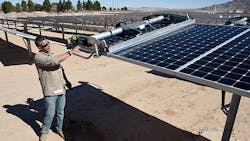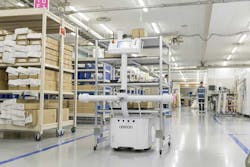by Shawn Donnan and Kevin Hamlin
The U.S. and China are on the brink of a new Cold War, with experts such as former U.S. Treasury Secretary Hank Paulson warning of a new "Economic Iron Curtain" between the world's two largest economies if they cannot resolve their strategic differences.
Ahead of a meeting with China's Xi Jinping at the Nov. 30-Dec. 1 Group of 20 summit, President Donald Trump has signaled his willingness to cut a deal. Yet, even if the two sides' deep differences can be overcome, any peace is likely to take months to wrangle and is unlikely to bring immediate relief for companies from the tit-for-tat tariffs that have hit almost 60% of goods traded between the U.S. and China.
As a result, companies around the world are being forced to re-examine where they make and buy components and products, with one eye fixed on what has become a new long-term risk to their business models. And, as they do so, an awkward reality is emerging: Any decoupling is likely to take longer and be more disruptive than Trump's "America First" protectionists argue.
"This is the struggle of our times," said Paul Triolo, head of global technology policy analysis at Eurasia Group in Washington. "And there will be lots of collateral damage."
The Trump White House has framed its trade war as a national security priority and a response to what it calls China's "economic aggression." Hawks within the administration see a broader parting of ways as vital to guarantee America's future preeminence. With tariffs and a newly aggressive focus on export bans in sectors such as semiconductors, they are encouraging U.S. companies to stay home and stop investing in China
"A new consensus is rising across America. More business leaders are thinking beyond the next quarter, and thinking twice before diving into the Chinese market if it means turning over their intellectual property or abetting Beijing's oppression," Vice President Mike Pence declared in an Oct. 4 speech likened by some to Winston Churchill's Iron Curtain speech warning of Soviet expansionism in 1946.
China, too, sees the battle as existential. During a visit to the manufacturing heartland of Guangdong province in October, Xi reiterated a mantra that China must strive to be self-reliant, especially on innovation.
The result of a standoff, Paulson warned in a speech last week at the Bloomberg New Economy Forum in Singapore, was a "moment of change in the global economy" and "unprecedented political pressure on cross-national supply chains."
"I fear that big parts of the global economy will ultimately be closed off to the free flow of investment and trade. And that is why I now see the prospect of an Economic Iron Curtain—one that throws up new walls on each side and unmakes the global economy, as we have known it," said Paulson, who served under George W. Bush.
The push by some in Washington for a decoupling has consequences for boardrooms far beyond the U.S. and China. European companies such as BMW AG are being forced by the new tariffs to rethink models that now see them export SUVs from South Carolina to China. Southeast Asian countries such as Vietnam are experiencing a new flood of interest as a manufacturing alternative to China.
Four products underscore the complexities facing businesses stuck between the dueling giants—rechargeable batteries, solar panels, pain-relief devices and hot tubs. A close look at those supply chains shows China's control of raw materials, entrenched competitive advantages and ability to find alternative buyers at home and abroad, as well as the way tariffs and retaliation to them cause higher prices to ripple across the world.
The Lithium Ion Battery
The Trump administration's trade war is aimed most directly at Beijing's "Made in China 2025" plan to lead the world in select industries by that year. High on the list: electric vehicles and all the things that go with them, including lithium ion batteries. Those batteries, in turn, are a good example of how hard shifting supply chains will be.
The U.S. now relies on offshore production for most rechargeable batteries, something the Pentagon pointed to as an area of concern in a September report on the potential national security threats embedded in America's dependence on international supply chains.
Manufacturers in China already dominate lithium-ion battery production and are set to continue doing so for years to come. China now accounts for more than 113,000 megawatt hours of the almost 175,000 of production capacity in the world, according to Bloomberg New Energy Finance data. The U.S. accounts for a little over 30,000 megawatt hours.
Moreover, Chinese capacity in China is expected to soar, potentially more than tripling in the next three years, adding the equivalent of two-and-a-half of Tesla Inc.'s massive "gigafactory" in the Nevada desert, which the company claims will be the largest building in the world when it's completed in 2020.
China also controls a substantial portion of the market for raw materials used in lithium-ion batteries, including processed lithium.
Companies such as Apple Inc. and Tesla have scrambled to lock in sources of metals like cobalt and lithium from suppliers in other countries. But businesses have also been lobbying the administration for exclusions from tariffs for both batteries and those raw materials.
In a September letter to U.S. Trade Representative Robert Lighthizerr, Mitsubishi Chemical warned that a proposed tariff on imported lithium hexafluorophosphate would paralyze its $38 million plant in Shelby County, Tennessee, the U.S.'s largest supplier of electrolytes to domestic battery makers. "There are presently no other viable sources of these inputs outside of China," Mitsubishi executives warned.
Washington relented and dropped those raw materials from a $200 billion list of goods it hit with tariffs in late September. It has also so far held off on imposing tariffs on lithium-ion batteries. But that could change in the months to come if peace is not forthcoming and Trump delivers on his threat to impose tariffs on all imports from China.
Solar Inverters
The solar industry has been one of those hit hardest by Trump's tariffs. The administration early this year imposed temporary "safeguard" tariffs on imported solar cells. In September it added tariffs on inverters—the boxes that convert power from solar panels into the alternating current used by household appliances and the grid.
According to John Smirnow, general counsel of the Solar Energy Industries Association, the majority of inverters used in the U.S. now come from China. That will change in the months ahead, but only because some Chinese companies are shifting their production overseas.
China's Sungrow, one of the world's biggest manufacturers of solar inverters, announced in April that it was setting up its first factory outside China in Bangalore, India. That illustrates how—if and when supply chains shift—some of the changes will be cosmetic, rather than structural.
With the new tariffs in place, Sungrow's India factory is likely to become the source for many of the inverters imported to the U.S., Smirnow said. Those inverters are also likely to continue to include mostly Chinese components.
The main impact for the U.S., meanwhile, will be a few quarters of higher prices as plants outside of China such as Sungrow's facility in Bangalore get up and running. It is unlikely to be the construction of any new inverter plants in the U.S.
The Opioid Alternative
For Omron, a Japanese conglomerate that makes robots, car parts and medical devices, the U.S.-China trade war is forcing a difficult conversation about how it helps Americans seeking relief from pain and whether it should continue doing so.
The "transcutaneous electrical nerve stimulation," or "TENS," devices it now sells in the U.S. are part of a wave of increasingly popular alternatives to highly addictive opioids. They are also made in China and, as of September, subject to a 10% tariff that's due to rise to 25% in January.
The problem for Omron is that the economics of moving production don't add up, according to Ranndy Kellogg, chief executive officer of its U.S. health-care unit. Last year, Omron's sales of "TENS" units in the U.S. were worth $10 million to $12 million and represented just a tenth of its global sales of the product.
Shifting manufacturing from a factory in China, at which it has been producing the units for a quarter century, to the U.S. would take years and involve an arduous regulatory approval process. It's not a realistic option. Retailers such as Walgreens and Walmart are also reluctant to entertain the idea of price increases.
The tariffs have created a bitter irony for Omron. It was looking to expand its pain business and TENS units, which use pads to send bursts of low-voltage electricity into nerves in areas affected by pain. They're increasingly popular among blue-collar workers with injuries as an alternative to the opioids that have caused a crisis in many parts of the country.
"This is a product that is helping people," Kellogg said. "It's not rich people. It's people who go to work every day and lift stuff and hurt their back."
Hot Tubs
The plight of Chinese hot-tub maker Shenzhen Kingston Sanitary Ware underscores how all sides get hurt in a trade war. Kingston doesn't sell to the U.S. but was hit by China's 10% retaliatory tariffs on imports of American-made control panels and acrylic shells. Those make up 65% of its costs, said Cash Liu, a sales director at the company, speaking at the Canton Fair in Guangzhou last month.
With Trump set to hike those tariffs to 25% in January and China likely to retaliate, Liu said Kingston is offering its existing customers, which are mostly from Europe and Australia, the option of switching to control panels from Canada and China-made acrylic shells.
For the 40% of customers who want to stick with U.S. components, that means higher prices, said Liu. The 60% willing to switch represent lost business for America.
China will also feel the pain. Liu said Kingston's profit margin is as low as 10%, and steeper tariffs will be a threat to the entire industry. "For us, it's a big shock," he said.





